Canaries: description of breeds, rules of keeping and breeding

Canaries occupy a special place among domestic bird species. These birds have a unique voice, variegated color and are not at all picky about keeping at home. In this material you will get acquainted with the description of the main breeds of canaries, as well as with the rules for keeping and breeding them.



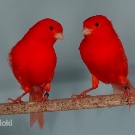


Description
Canaries are a species of domesticated birds from the Finch family, native to the Canary Islands and the Azores. These birds have variegated and bright plumage, can grow up to 23 cm in length and usually do not gain more than 50 grams in weight.
In their natural environment, canaries live in dense deciduous forests, groves, and prefer to nest in an area over 1500 meters above sea level. The diet of wild canary includes fruits of fruit trees, plant seeds and some insects.

Canaries began to be tamed 500 years ago. During this time, the bird's vocal apparatus was corrected, thanks to which these birds are known today not only for their colorful plumage, but also for their singing talent.


Pros and cons of home content
The content of canaries has its positive and negative aspects.
Pros.
- Most canary species are very small birds that do not require large cages or enclosures to keep. In addition, small birds eat small portions of food.
- Canaries can be considered one of the most talented birds in the world - their singing is not only beautiful: it is multi-level, iridescent and very loud.
- Among the canaries there are not only talented singers, but also incredibly bright and beautiful birds. Many breeders raise these birds precisely because of their non-standard plumage.
- Canaries are very restless, sociable and incredibly social birds. It's never boring with them - in many families, canaries become full-fledged family members on a par with other animals like cats and dogs.

Minuses.
- The main disadvantage of keeping any birds is a large amount of garbage, feathers and excrement. This forces canary owners to regularly clean the cages and rooms where the birds are.
- Male canaries have excellent hearing and very loud voices, which can distract from watching movies or interfere with sleep for children. At the same time, in order to get beautiful melodies, canaries must be specially taught with the help of regular listening to the singing of other birds. If the canar is not trained in singing, then it will simply make loud, creaky and annoying sounds. Usually decorative kenars are distinguished by bad singing.
- As already mentioned, canaries are very social birds, and therefore they constantly need attention. It is not recommended to leave these birds alone in the apartment for a long time.
- If you are going to buy a decorative breed of canaries, then be prepared that such birds will need to be tinted regularly to maintain their rich and vibrant color.
- Useful curiosity is not about canaries. These birds are not only restless and active, but also love to poke their beak everywhere. If you let the canary fly around the apartment, then it is imperative to close all windows and doors, remove all containers with liquids, all chemicals and any human food.
Canaries love to fly behind sofas, armchairs, or simply hide from the owner behind obstacles - during such games, birds can be poisoned by old products that accidentally fell behind furniture.
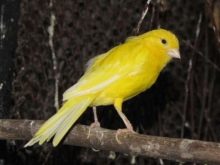


How to determine age and how long do they live?
Not all nurseries and even professional breeders record the age of their canaries and report it during transfer to private hands. Unfortunately, it is rather difficult to determine the age of such birds without documents and a passport.
To determine the age, you need to pay attention to the beak, legs and plumage of the bird, as well as its behavior. In young individuals of the canary, the beak and legs are pink, smooth and not covered with characteristic scales.
In addition, young canaries are very active, restless and sociable - it is difficult to keep them in one place.

When buying a well-groomed bird from a private breeder, determining the age is even more difficult - in old and adult canaries, with careful care, there may be no scales, and a balanced diet can make even adult birds active.
Canaries usually live no longer than 10 years in their natural environment, however, some species, with proper care and nutrition, can live up to 12-15 years.

Species overview
Currently, researchers identify about 100 varieties of canaries, but only a few of them are grown at home. The most popular species and breeds of these birds will be presented below.
- Colored. This group includes all breeds of canaries with non-standard and variegated flowers in plumage: yellow (lemon-colored birds up to 17 cm long and weighing up to 40 grams), white (German and English breeds stand out here - the first has a lilac plumage, the second has the fold of the wing is yellow), red (this includes birds of red, orange and mosaic color), ivory (ivory plumage with a pinkish tint), as well as breeds with red eyes (or albinos).

- Melanin. This includes all breeds with a non-solid or non-standard color: green (lemon belly, black head and dark wings), gray (look like sparrows with a gray breast and an orange beak), black (all breeds of bronze, copper and maroon color),brown (birds from cream to chestnut tones), as well as isabella breeds (pink or variegated plumage of the "swallow" type).


- Decorative. In this series, the researchers identified all birds that are valued for their non-standard appearance (usually curly or curly plumage). The most famous breeds are Meninger Curly, North Curly, Swiss Curly and Italian Curly.

- Humpbacked. This includes all birds in which the head in a calm position is lowered below the shoulders, and the body is stretched out in a vertical line. Usually these are yellowish or white birds. Breeds: Belgian, Munich, Scottish and Japanese.

- Crested. All breeds of canaries are located here with a characteristic withers on the top of the head, which was formed due to experiments to increase the plumage. The most famous breeds are Gloucester, Lancashire, German and English.

- Curly. This variety includes all individuals of canaries, which have an even, beautiful and contoured plumage. Popular breeds: Swiss, Spanish decorative, Norwich, Border canary, and Yorkshire.

Selection Tips
It is best to buy a canary from a nursery where you can observe their behavior. According to certain criteria, you can choose a healthy, talented and active canary for yourself.
- A healthy canary always behaves actively and vigorously - it does not sit still, but actively moves around the cage, communicates with other birds and from time to time pecks food from the feeders.
- Pay attention to the bird's eyes - in healthy individuals they are always open, and in sick individuals the eyelids are closed, while it can sit in one place and have a ruffled appearance.
- A healthy canary has a smooth and close-fitting plumage - do not believe the breeder's words about the beginning of the molt period.
- Even if the canary is actively jumping, flying and playing, its breathing remains even and calm. Only in cases of aggression and fright the bird's breathing quickens and the beak opens slightly.
- Examine the condition of the bird's legs - in young individuals they should be pinkish, without scales and growths. These signs indicate a serious illness or an advanced age of the bird.
- Healthy canary droppings should be firm and firm, never runny.
- When choosing a singing kenar, it will be useful to first listen to how he sings, and then buy an individual. Canaries' tunes are very different, and not all of them will be pleasing to the human ear.

How to care?
Canaries are considered the ideal bird for beginners - they are sociable, accept almost any food and are undemanding to keeping in a private house or apartment.
When keeping kenars, you need to be puzzled by the purchase of a high-quality and fairly spacious cage. The material of its manufacture in this case is not important (there can be both wooden and metal models), however, it is better to refuse polymer cells. Optimal dimensions are 30 cm high, 35 cm long, 20 cm wide.
It is better to choose a cage with built-in perches, mirrors, toys and feeder stands (options with retractable feeders will be most convenient).

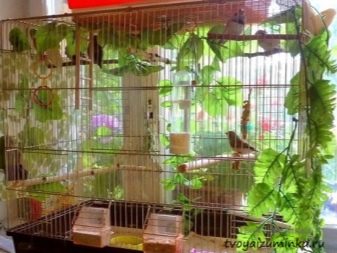
Be sure to install a container of water in the cage where the bird can sometimes swim - canaries just love to take baths. As for the location of the bird cage, it is best to choose a well-lit and ventilated place without drafts and direct sunlight. In addition, the bird's cage must be constantly in the human field of vision.
At least 2 times a week, clean your pet's cage thoroughly. It is easiest to scald metal models with boiling water and dry.

Poultry nutrition should be not only balanced, but also timely and varied. Try to feed your canary at a specific time each day. At the same time, the poultry ration should not consist of a specific feed, which must be regularly supplemented with fruits.
Try to spend more time with your feathered friend.
Lack of communication can affect not only the mood of the bird, but also its appetite, and can lead to serious illness.

How to feed?
Correct and balanced nutrition improves the plumage of birds, strengthens their immunity and prolongs their lifespan. Canaries should have 3 food groups in their diet.
- Cereals. The canary's body perfectly assimilates almost all grains. Suitable for her are wheat, barley, corn, buckwheat, rice, millet and oats.
- Oilseeds. This group includes foods high in healthy fats and oils: rapeseed, chestnuts, acorns, as well as bran, sunflower seeds and nuts.
- Fresh. This group includes products of plant origin - fruits rich in vitamins: apricots, grapes, cherries, apples, peaches. Healthy canary vegetables include cabbage, celery tubers, spinach leaves, bell peppers, and carrots. If we talk about dried fruits, then raisins, prunes, dates, dried apricots and figs are sometimes added to canaries as a top dressing or delicacy. Canaries digest fruit juices quite well, but with an exceptionally low percentage of sugar.
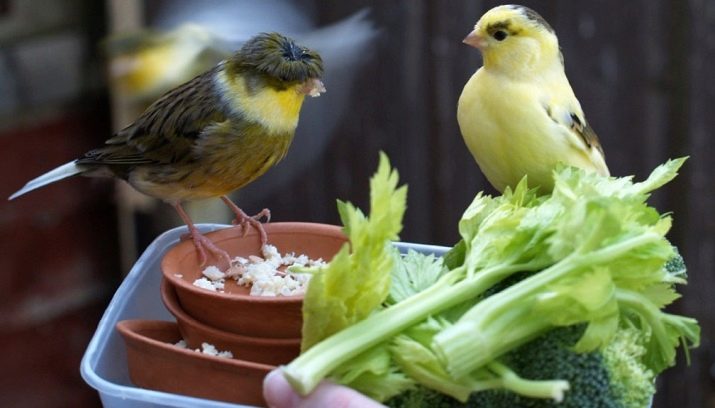
To products that not suitable for consumption by a canary, includes fruits that are high in fat, starch and sugar. In addition, this also includes vegetables and fruits with a high level of acidity.
From fruits and vegetables to canaries it is forbidden to give potatoes in any form, persimmon, mango, papaya, avocado, as well as herbs - parsley, dill and basil... In addition to fruits and vegetables, the diet also includes there should be no salty, pickled, boiled and fried foods.


In the cold winter and autumn seasons, the body of canaries is at serious risk, which is why the diet of these birds should include twigs of fruit or deciduous trees at this time. Young branches of apple, alder, cherry, birch, mountain ash, linden, raspberry, currant, willow, aspen and alder are perfect for them. As a vitamin supplement of animal origin, fish oil, cottage cheese with a low percentage of fat content, boiled eggs, honey and special supplements from dried insects can act.

Often, domesticated canaries choose the tidbits of food in the feed, and leave the rest of the food intact.
To avoid this problem and not provoke obesity in birds, you need to determine a strict daily feed rate for them. Typically, one adult canary needs at least 1.5 teaspoons of grain feed every day. This amount may vary slightly depending on the breed, age and health of the bird. Increased appetite in canaries is observed during molting, as well as during nesting and feeding of chicks.
From time to time, soft food is added to the canary menu. It can be a mixture of half a hard-boiled yolk and one teaspoon of crackers or semolina, and you can also add some poppy seeds here.
Fruits and vegetables are added to the canary diet in thin slices. Usually they are placed in cages on metal hooks from where the birds can peck at them. After eating, all food is immediately removed from the cage. Otherwise, birds may eat spoiled food.
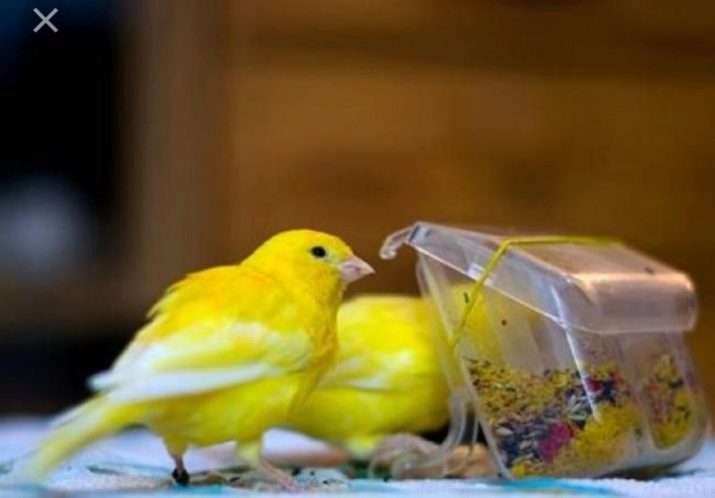
An important element of the canary's nutrition is clean and fresh water. Birds need it not only for food, but also for beautiful singing and bathing. For drinking, both ordinary filtered tap water (or settled water) and special bottled water for canaries are suitable.
If you want to change the bird's diet or completely change the main feed, then the transition should take place gradually. Increase the amount of new food in your canary's diet daily. If you buy birds by hand, then be sure to ask what their menu included earlier.

How to tame?
Some people prefer to catch canaries rather than buying them from nurseries. The most important moment during the taming of wild canaries is that you need to constantly communicate with the birds and devote as much time to them as possible. Also, be sure to give your bird a name and repeat it repeatedly when referring to it. Create the most natural conditions for the bird in the cage. There must be toys, perches on which the bird could sit and sing; it would be nice to install a warm and cozy nest in the cage.
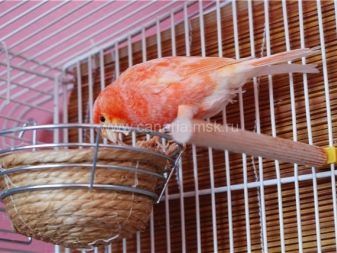

In the early days, canaries will be very scared of you and react negatively to sudden movements and loud noises. Especially when cleaning, try not to make loud noise or gesticulate. Once the bird gets a little used to you, you can try hand-feeding the canary. For this place some food on your palm and gently bring it to the bird.
If the bird dares to eat from your palm, you can let it fly around the room for a short time. Such rare walks will greatly improve the bird's mood and make it more cheerful, improve its appetite. When walking, be sure to close all windows and doors tightly.
Usually the kenars begin to sing themselves - first, small short melodies, and then long trills. To teach a bird to sing, you need to sometimes turn on audio recordings of canaries singing in the room so that your bird listens and remembers them.
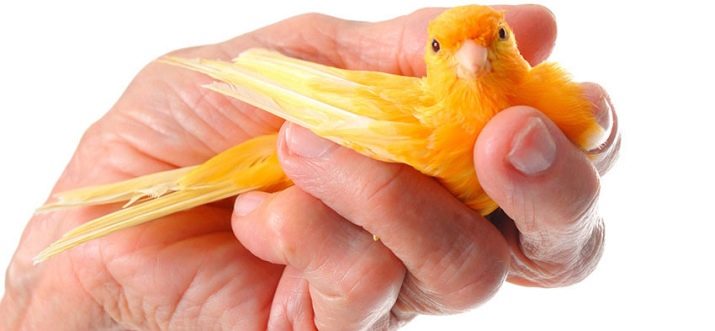
How to distinguish a female from a male?
At birth, nestlings of canaries are almost identical and do not have sex differences, however, over time, sexual dimorphism is still expressed in several factors.
- Typically, female canaries have a slightly shorter tail than males.
- Male canaries are distinguished by loud, multistage and iridescent singing. In addition, while singing, their goiter characteristically puffs up. Females usually make short and monosyllabic sounds.
- During the nesting period, females are actively engaged in creating a nest, while males most often simply look after their spouses: they bring them food and sing.

Breeding rules
The best times for mating and nesting of birds are considered April or May... For this, healthy and active individuals over 1 year old are always selected. If you want to breed singing kenars, pay attention to the voice of the male in a pair - the talent of singing is inherited by the chicks.
The female incubates eggs for about 2 weeks, at which time the male is nearby and sings to her, brings food and entertains her in every possible way. During this period, the female needs a balanced diet with the obligatory presence of boiled eggs with crushed breadcrumbs in the diet.
As soon as the chicks are born, the male sometimes needs to be removed from the cage - it depends on how he will behave with the offspring. There are also caring kenars who actively help females during incubation and feeding of chicks.

About a month after the offspring are born, the chicks are deposited in new cages and reared separately. They are fed with special grain mixtures, while the conditions of their maintenance remain standard. At this time, you should not expect singing from the canaries - it appears only for 2 years of life.

For breeding canaries, see the video.
Compatibility with other birds
Usually, canaries are not advised to keep in the same cage with birds of other species - in this case, there is a struggle for territory, the attention of the owner, and even for food. Most often, breeders try to add budgies or goldfinches to canaries, but such experiments rarely end with success.

Besides, these birds need completely different nutrition, other vitamins and conditions of keeping. I must say that a lot depends on the nature of your canary - if she is calm about the birds in other cages and does not tease pets, then as an experiment you can try to hook these birds together and breed them.
Most often, canaries are hooked up to other canaries, however, about the same age and the same species.

Necessary accessories
So that the canary does not feel sad during the absence of the owner and always knows what to do, several toys must be placed in the bird's cage - a mirror, bells, special houses, as well as perches on which the birds will rest and play.
A healthy canary never sits in one place for a long time, and entertainment helps her to throw out energy, develop muscles and strengthen immunity.
Adult canaries sometimes need claw trimming - for this, breeders buy special grooming scissors.










